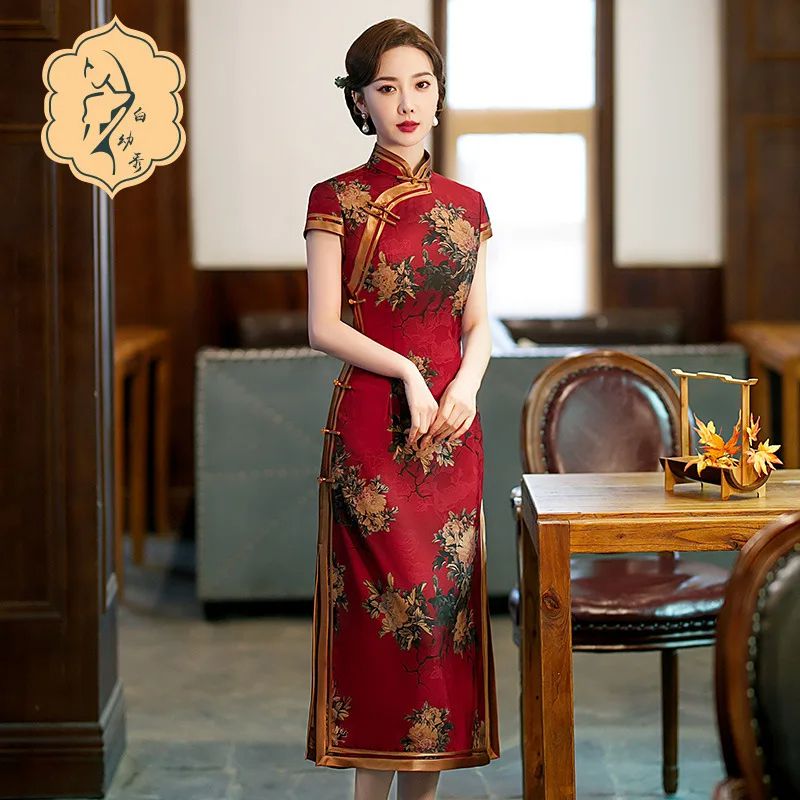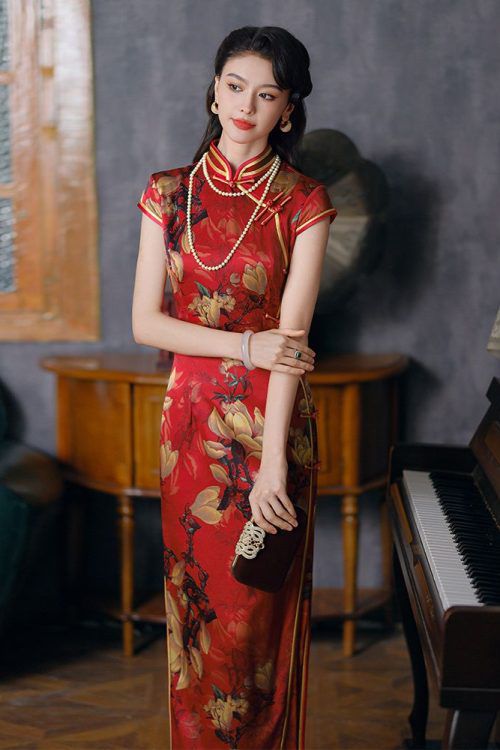The Historical Evolution of Flower Patterns on 旗袍
Introduction
The Qipao, an iconic Chinese dress, is renowned for its intricate and captivating flower patterns. The origins of these patterns can be traced back to ancient Chinese culture, where flowers held profound symbolic meanings.
Early Beginnings: Tang Dynasty
During the Tang Dynasty (618-907), flowers became a prominent motif in art and fashion. Peonies, symbolizing wealth and prosperity, were particularly favored. These floral designs were often embroidered onto silk robes, creating garments of exquisite beauty.

Ming Dynasty: Evolution of Floral Patterns
As the Qipao evolved over the centuries, flower patterns continued to play a significant role. During the Ming Dynasty (1368-1644), the Qipao took on a more form-fitting silhouette, and floral patterns became smaller and more delicate. Chrysanthemums, representing longevity and purity, were commonly used.
Qing Dynasty: Elaborate Floral Designs
The Qing Dynasty (1644-1912) witnessed a resurgence of interest in traditional Chinese culture. Flower patterns on Qipaos became more elaborate and diverse. Lotus flowers, symbolizing purity and enlightenment, were often depicted alongside other auspicious motifs such as dragons and phoenixes.
Early 20th Century: Modernization and Western Influence
In the early 20th century, the Qipao underwent a period of modernization. Western influences led to the incorporation of new floral designs, such as roses and lilies. These patterns were often printed or embroidered onto fabrics in vibrant colors.
Republican Era: Nationalism and Floral Patterns
During the Republican era (1912-1949), the Qipao became a symbol of Chinese nationalism. Floral patterns continued to be popular, but they were often combined with patriotic motifs, such as the Chinese flag or the Great Wall.

Post-1949: Renewed Interest in Tradition
After the founding of the People’s Republic of China in 1949, the Qipao’s popularity waned somewhat. However, in recent decades, there has been a renewed interest in traditional Chinese culture, and the Qipao has once again become a fashionable garment.
Contemporary Designs
Today, flower patterns on Qipaos continue to draw inspiration from ancient Chinese traditions. They are often used to convey auspicious wishes and to celebrate Chinese heritage. Whether embroidered, printed, or painted, these patterns add a touch of elegance and beauty to this timeless dress.
Cultural Influences on the Floral Motifs of Qipao
Introduction
The qipao, an iconic Chinese dress, is renowned for its intricate floral patterns that evoke a sense of elegance and femininity. The origins of these patterns can be traced back to ancient Chinese culture, where flowers held profound symbolic meanings.
Tang Dynasty Influences
During the Tang Dynasty (618-907), flowers became a prominent motif in Chinese art and literature. The peony, known as the “king of flowers,” symbolized prosperity and wealth. The lotus, with its pure white petals, represented purity and enlightenment. These floral motifs were often depicted on textiles, including the qipao.

Qing Dynasty: Western Aesthetics
As the qipao evolved over the centuries, it incorporated influences from various cultures. During the Qing Dynasty (1644-1912), Western aesthetics began to permeate Chinese fashion. European floral patterns, with their vibrant colors and naturalistic designs, were introduced into qipao designs.
Early 20th Century: Nationalism and Revival
The early 20th century witnessed a resurgence of Chinese nationalism, which led to a renewed appreciation for traditional motifs. Floral patterns on qipaos became more elaborate and symbolic. The plum blossom, a symbol of resilience and hope, became a popular choice. The orchid, representing elegance and refinement, was also frequently featured.
现代 Era: Diverse Inspirations
In the modern era, qipao designs continue to draw inspiration from both traditional and contemporary sources. Floral patterns have become more diverse, incorporating elements from different cultures and artistic styles. Some designers have experimented with abstract floral motifs, while others have embraced the use of bold colors and unconventional patterns.
Cultural Significance
The floral patterns on qipaos are not merely decorative elements; they carry deep cultural significance. They reflect the rich history and diverse influences that have shaped Chinese fashion. From the symbolic meanings of ancient flowers to the fusion of Eastern and Western aesthetics, the floral motifs on qipaos embody the enduring beauty and cultural heritage of China.
The Symbolism and Meaning Behind Flower Patterns on Qipao
Introduction
The Qipao, an iconic Chinese dress, is renowned for its intricate and captivating flower patterns. These patterns, far from being mere embellishments, hold profound cultural and historical significance, tracing their origins to ancient Chinese traditions and beliefs.

Ancient Symbolism
In ancient China, flowers were revered as symbols of beauty, prosperity, and good fortune. The peony, with its lush blooms, represented wealth and honor, while the lotus, with its purity and resilience, symbolized enlightenment and spiritual growth. These floral motifs were often incorporated into textiles, including the Qipao, to invoke auspicious blessings upon the wearer.
Qing Dynasty: Opulence and Refinement
During the Qing dynasty, the Qipao emerged as a fashionable garment among elite women. The intricate flower patterns on these dresses reflected the opulence and refinement of the era. The use of vibrant colors, such as 红, 绿化, and blue, further enhanced the visual appeal of the Qipao, making it a statement of both beauty and status.
Personal Expression
The flower patterns on Qipao also served as a means of personal expression. Different flowers carried specific meanings, allowing women to convey their hopes, dreams, and aspirations through their attire. For example, a Qipao adorned with plum blossoms symbolized perseverance and resilience, while one with magnolia flowers represented purity and nobility.
Modern Adaptations
In modern times, the flower patterns on Qipao have evolved to reflect contemporary aesthetics and cultural influences. While traditional motifs remain popular, designers have also incorporated modern elements, such as abstract patterns and geometric shapes, to create unique and stylish designs.
Cultural Heritage
The symbolism and meaning behind flower patterns on Qipao extend beyond their aesthetic appeal. They represent a rich tapestry of Chinese culture, history, and beliefs. By understanding the significance of these patterns, we gain a deeper appreciation for the beauty and cultural heritage of this iconic garment.
